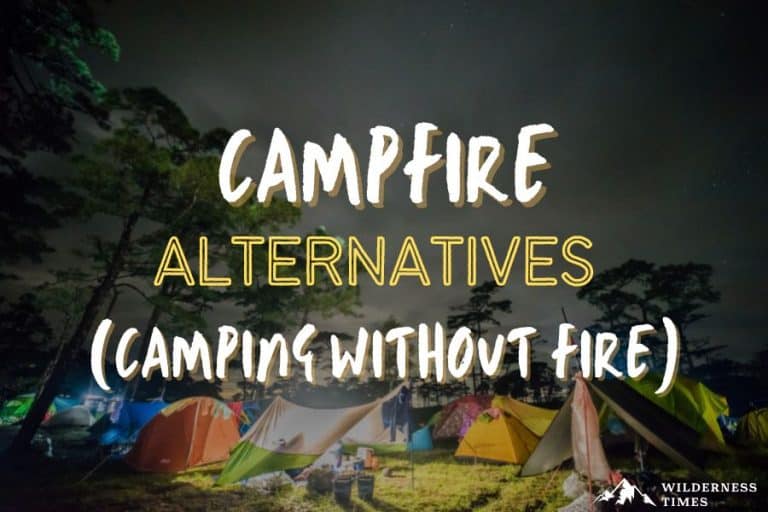Nothing says camping like gathering around the campfire and toasting marshmallows.
Unfortunately, you don’t always get to do that.
Especially during fire bans.
But don’t worry. Just because you can’t make a campfire doesn’t mean you’ll stay cold and hungry.
In this article, we’ll go over everything you need to know about fire bans, as well as what you can use during this time of the year.
Let’s dive in.
Fire Restrictions
Alright, let’s get straight to the point – everything you need to know about fire bans.
Why Are There Fire Restrictions?
Summer months can be extremely dry and hot in certain regions across the country.
Such an environment is easily susceptible to wildfires. Even the smallest airborne spark can cause an open flame that spreads fast.
To minimize the chances of that happening, authorities implement fire restrictions during these critical months.
The length of the fire season differs from region to region, depending on the climate.
In certain states, such as California, fire season can last from May to November.
During extreme drought, these fire restrictions can be very specific, banning all types of open flames.
Other times, only campfires and smoking is banned.
How to Check if There Are Fire Restrictions Near Your Campsite?
Not sure if a fire ban is in place in the area where you’re camping?
Luckily, you can easily find that out.
The quickest way would be to go online and check the websites of any of the land management services.
Your best bets are the US Forest Service, National Park Service and Bureau of Land Management.
These websites have specific information on fire restrictions currently implemented in areas across the country.
Alternatively, you can always visit the nearest ranger station and ask for more information.
In fact, you could probably get that info via a phone call.
You can also check the National Weather Service for regular updates on weather warnings.
Different Fire Restriction Levels
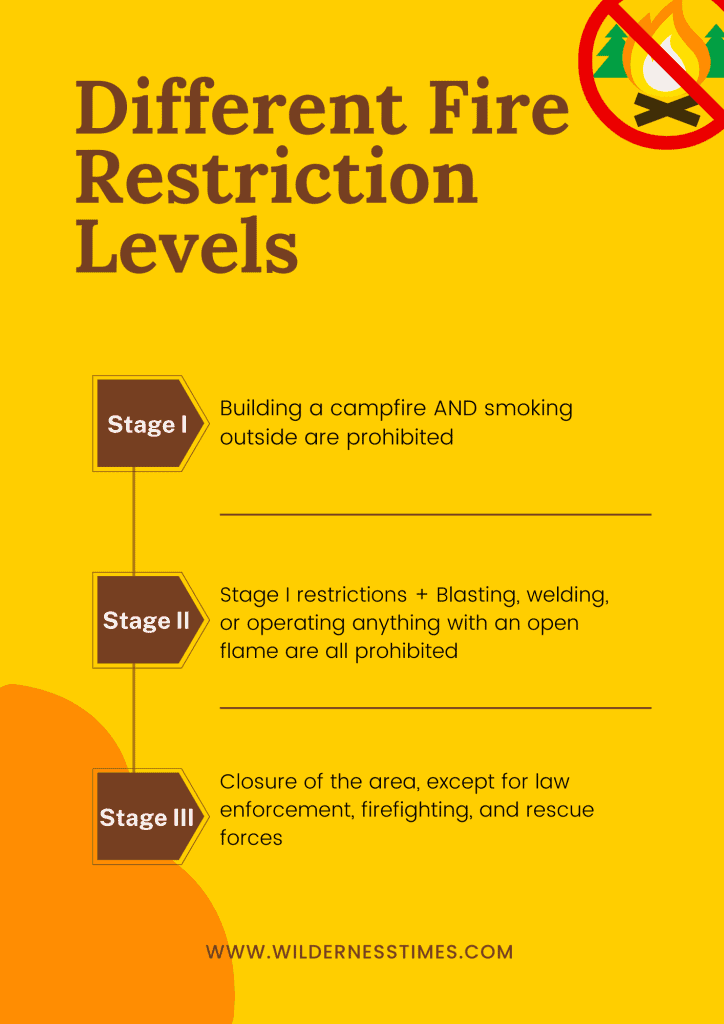
So what exactly is prohibited during fire restriction?
Well, that depends on the restriction level.
There are three different stages of fire restriction.
Stage I
Stage 1 is implemented when there’s an increased danger of wildfire.
During this time, building a campfire and smoking is prohibited.
However, there is a possibility that you may be able to have a campfire inside a designated ring inside an official campground, as that’s considered to be a low-risk area. Likewise, smoking may also be allowed there.
Stage II
In case the risk further increases, the Stage II restriction is implemented. While this fire ban level is in place, a few other things are prohibited.
Not only are you not allowed to start any kind of fire, but blasting, welding and operating anything with an open flame is prohibited.
Finally, you can’t drive a motor vehicle off-road, except to park in an area without vegetation within 10 feet of the roadway.
Stage III
A Stage III restriction is the closure of the area.
The exception is law enforcement, firefighting and rescue forces.
Campfire Alternatives (Camping Without Fire)
But you don’t need a campfire to enjoy your camping trip.
In this section, we’ll cover some alternatives that you can apply in different situations.
How to Stay Warm Without a Campfire
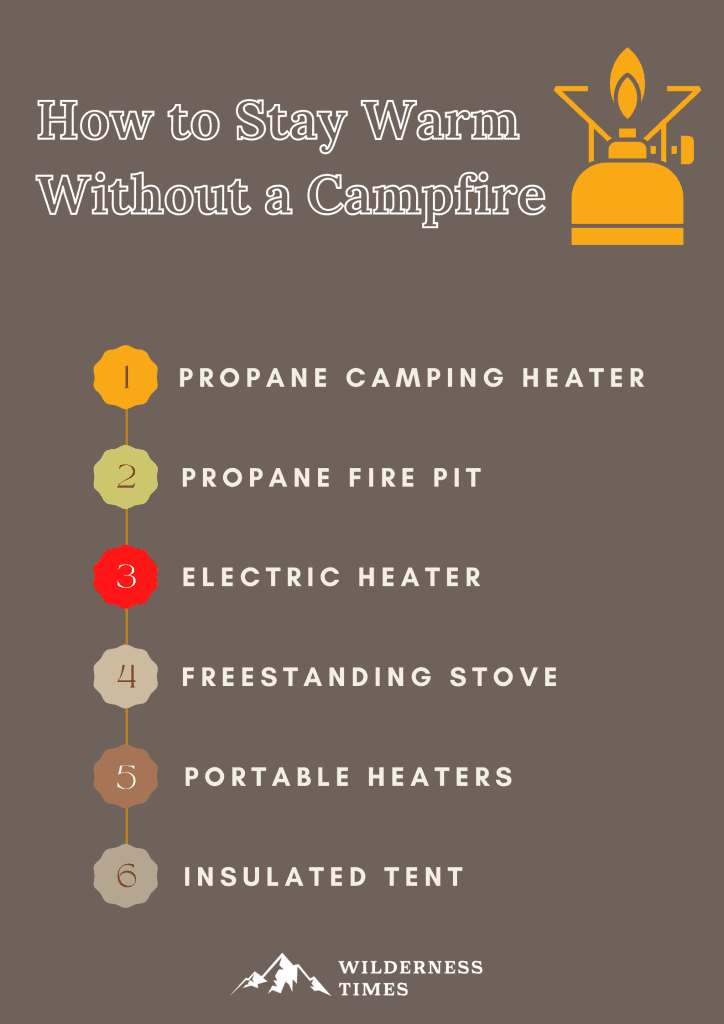
Don’t worry. Fire isn’t the only way you can warm up yourself while camping. There are a few other alternatives you can use instead.
Propane Camping Heater
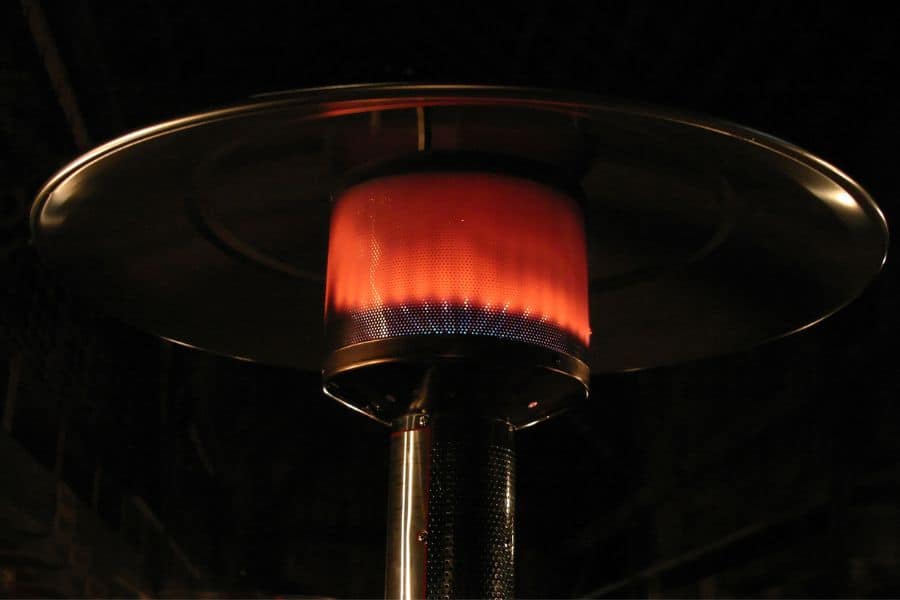
A propane heater is probably your best bet for staying warm inside your tent during a cold night.
Now, you’ve probably heard about propane heaters not being safe to use indoors. Well, that’s not always the case.
There are tons of models nowadays designed for indoor use.
These indoor-safe heaters are usually smaller in size, which makes them suitable for both tents and RVs.
And to be able to work indoors, these heaters feature automatic shutoff switches to prevent CO from building up to dangerous levels.
Of course, fancy technology also means they cost more than their outdoor-use counterparts.
In the case of a propane heater, it’s really worth investing in additional features.
So for instance, you should look for a product with overheating protection and automatic shutdown if tipped.
Propane Fire Pit
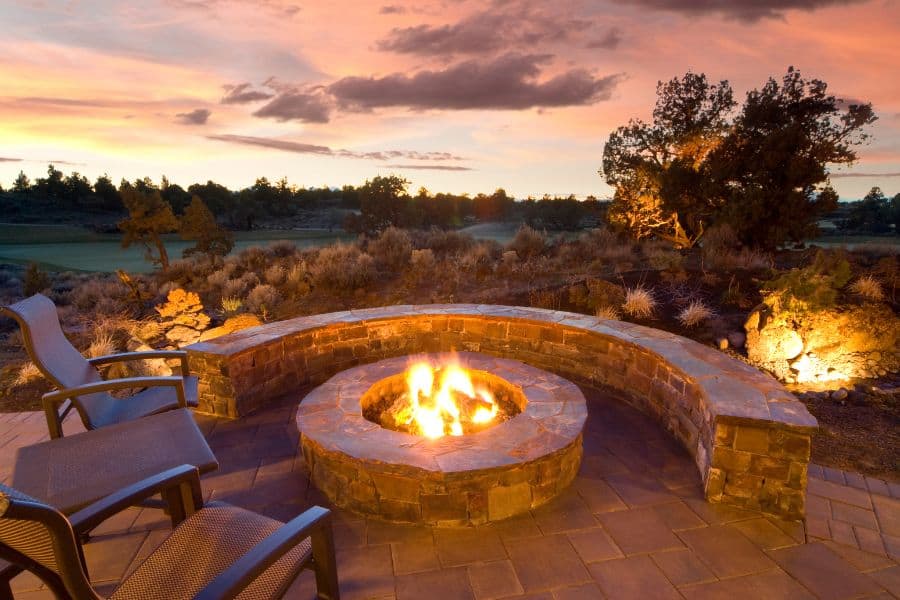
A gas-powered fire is as close as you can get to a real campfire during the fire restriction period.
It does a great job of keeping you warm, it’s easy to use and mess-free to pack up.
A propane fire pit does take a bit of space, so it’s only suitable when you’re driving a vehicle up to the camp spot.
Some models come with additional decors, such as lava rocks or fake wood for an even cozier atmosphere.
You can also use this fire pit to make food, as propane burns hot and steady. But, you’ll probably also need some additional pieces of equipment.
Electric Heater
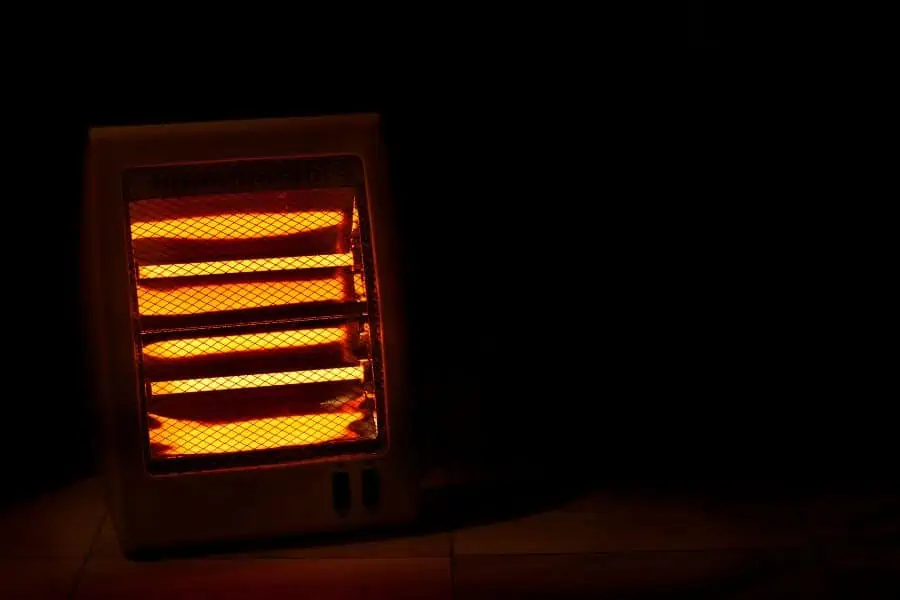
If you have access to an electrical outlet at your campground, then you can heat up using an electric heater.
Alternatively, if you own a generator, you can use that to power this little heating element.
With an electric heater, you really get what you pay for. Basically, what these appliances do is blow out hot air from the fan.
There are some pretty cheap models available, but they’ll only be able to heat up a small and well-insulated tent.
But even an expensive one won’t be able to keep you hot outside. These heaters are only designed to work indoors.
Freestanding Portable Stove
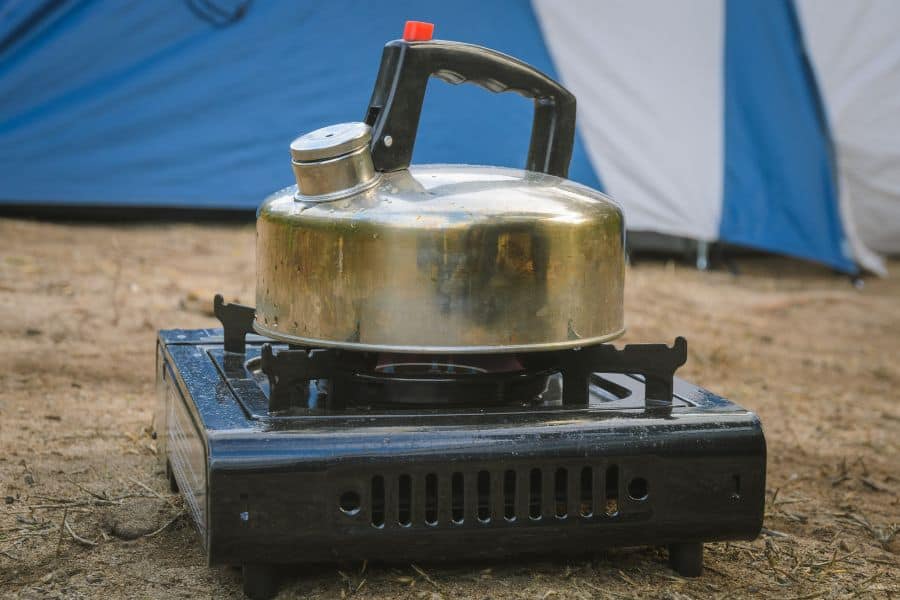
Now, this is definitely not a suitable alternative when space and storage are issues. Freestanding portable stoves are both large and heavy.
But, that also means they’ll work well to keep you warm when you’re gathered outside the tent.
Not as snuggly as you would inside, but still nice nonetheless. Just make sure it won’t rain before putting this thing up.
A freestanding portable stove does provide some light in addition to heat, which adds up a bit to the whole atmosphere.
Portable Heaters
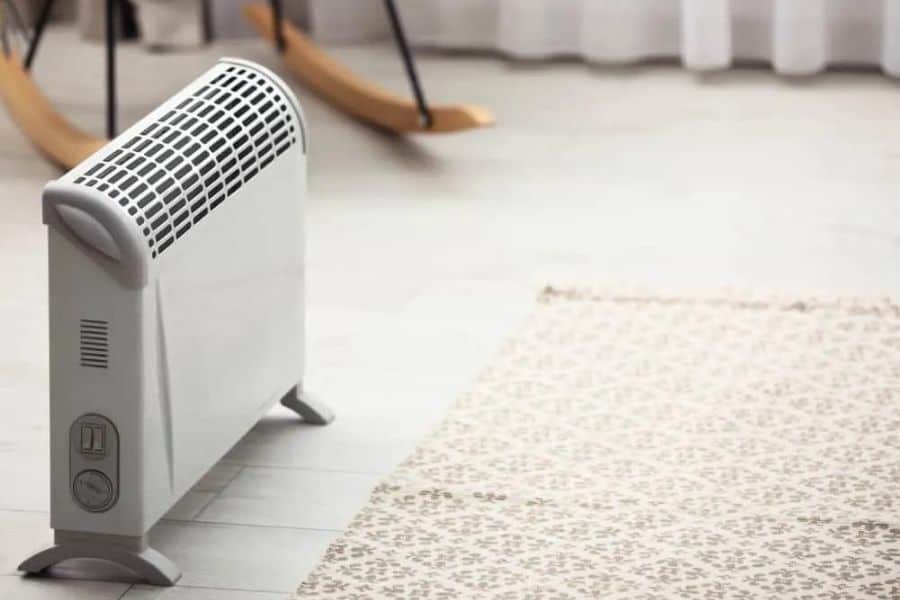
Portable heaters come with different price tags, depending on the area they’re able to heat.
But no matter how high you might go, don’t expect this appliance to keep you warm outside the tent.
Inside the tent is a different story. A portable heater performs well, even without proper airflow.
Unfortunately, you’ll need either an electric outlet or a generator to be able to use this appliance while camping.
Insulated Tent
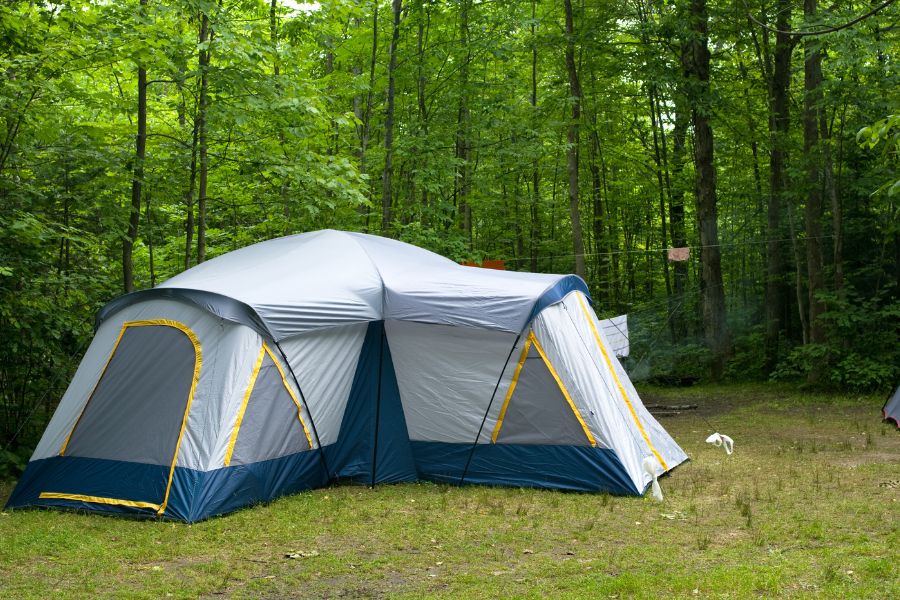
The key to staying warm on a really cold night is an insulated tent.
You can use the best heater out there, and the warmth will just escape through it unless it’s well insulated.
If you’re winter camping, then investing in such a tent is definitely worth it.
This type of tent has an additional layer of thermal insulation between the two walls, which prevents heat from escaping the tent.
Read: How To Insulate A Tent For Winter Camping
Bundle Up
Sleeping in your favorite t-shirt simply won’t cut it on a cold night in the wilderness.
Now, that doesn’t mean you should wear a jacket while rolled up into a sleeping bag. You’ll just end up waking up in a puddle of your own sweat.
The easiest way to heat up as the temperature goes down at night is to wear layers.
First, wear a moisture-wicking next-to-skin layer. By this, I mean long underwear made of either wool or polyester.
From here, you can add more layers if it starts getting colder. Additionally, you can wear a beanie and socks to warm up your head and toes.
Then, as the sun starts rising, you can start removing the added laters.
Alternatives to Campfires For Cooking
Just because there’s a fire ban in place, that doesn’t mean you can enjoy a hot meal or at least a cup of coffee.
Here’s what you can use instead of a regular campfire for cooking.
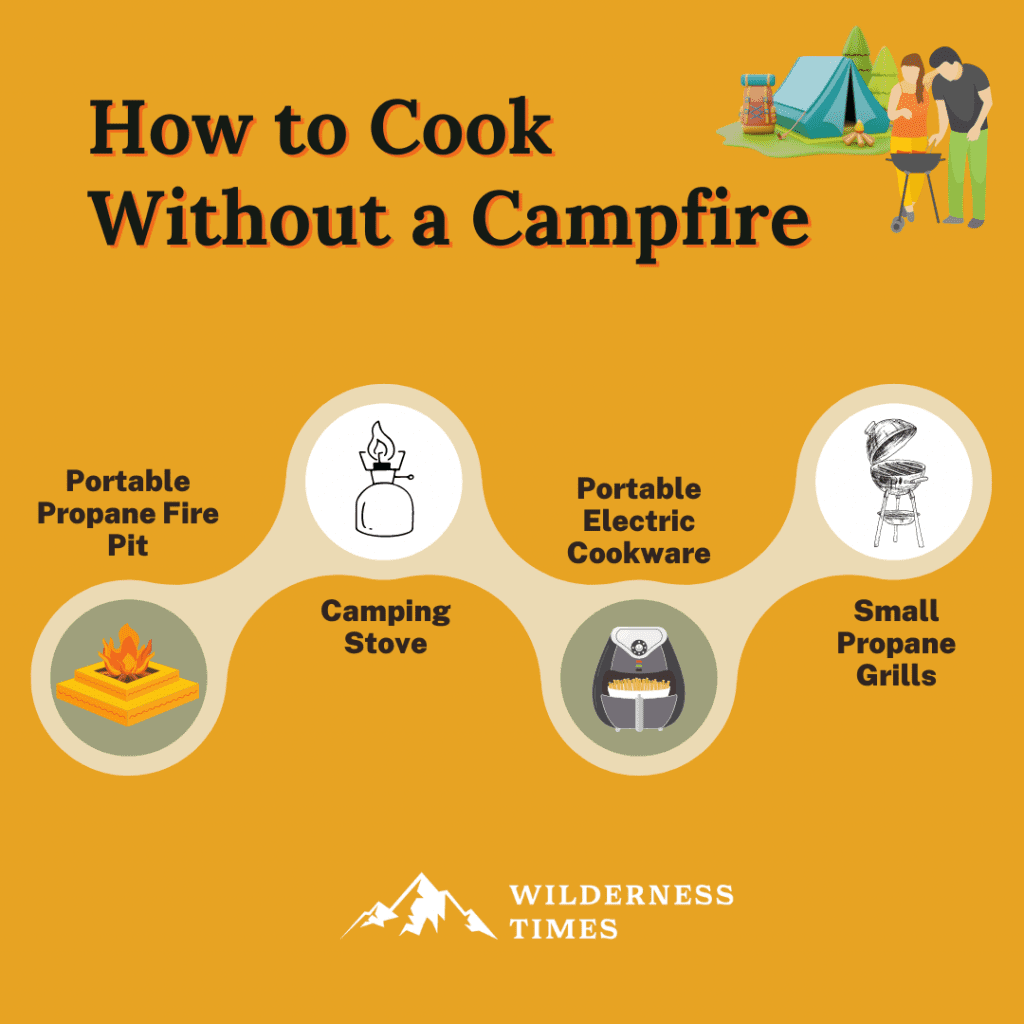
Portable Propane Fire Pit
I’m a big fan of propane fire pits, because you can gather around them as you would around a real campfire.
This means you can enjoy marshmallows and hot dogs with your camping mates like in old times.
You’ll need to buy additional equipment to cook on a propane fire pit, namely a grate. You can cook directly on it or place a Dutch oven or a pan over it.
Just don’t cook anything too greasy directly onto the grate, as it might cause flare-ups.
Camping Stove
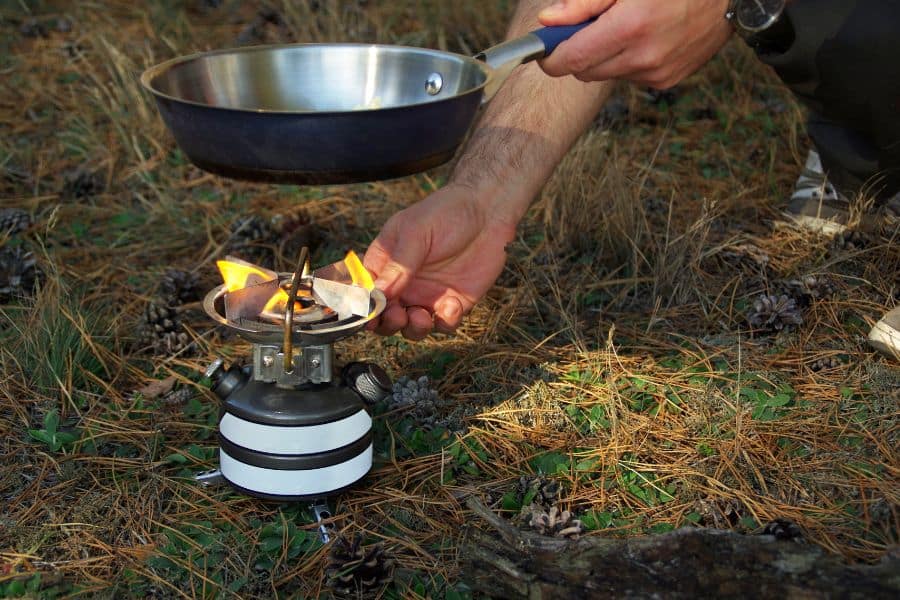
If you’re cooking for one or two persons, then a camping stove will be more than sufficient for your needs.
Plus, they’re light and compact, so they’re great for long-distance camping.
Now, you have several fuel options to choose from, such as propane, butane and liquid gas.
Which camping stove is the best for you depends on the type of your trip. For instance, gas is better for backpacking, while liquid fuel is more suitable for high altitudes.
Portable Electric Cookware
Not exactly intended for camping, but portable electric cookware can be handy during fire restrictions.
If you own a portable frying pan, hot pot or cooking plate, bring it on your camping trip. It can make preparing food much more convenient.
Of course, you’ll need access to electricity to run these appliances.
Small Propane Grills
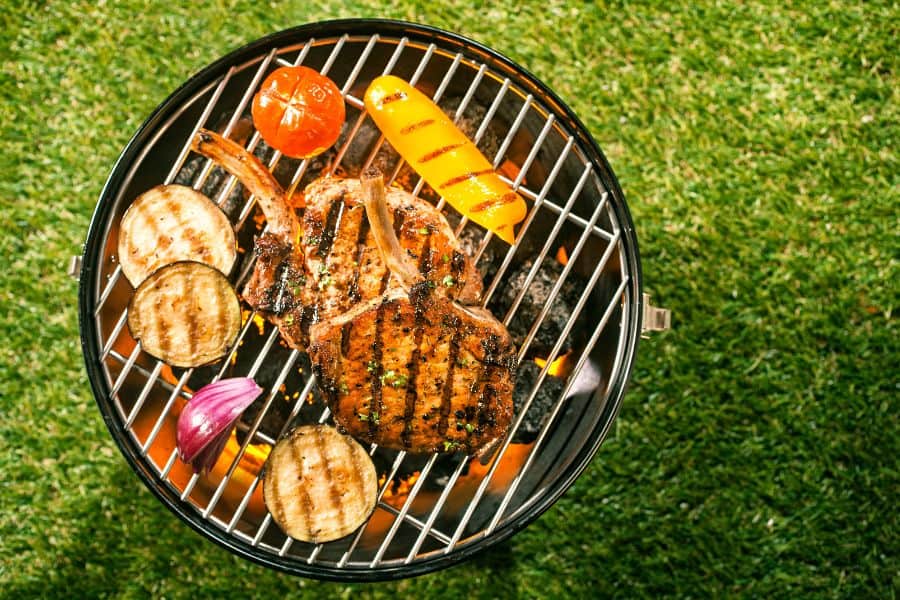
If storage is not an issue, you can also bring a small propane grill on your camping trip.
They’re a bit heavy to carry around, but since they’re compact, they won’t take up too much space in your trunk.
Propane is affordable and canisters are readily available at outdoor stores. What’s more, you can refill it at most gas stations.
That’s much cheaper than buying a new canister each time. Plus, it’s more environmentally friendly.
Alternatives to Campfires For Lighting
Without a campfire set up in the middle of the campsite, nights may seem too dark.
But that doesn’t have to be the case, as there are other ways you can enlighten the area around your tent.
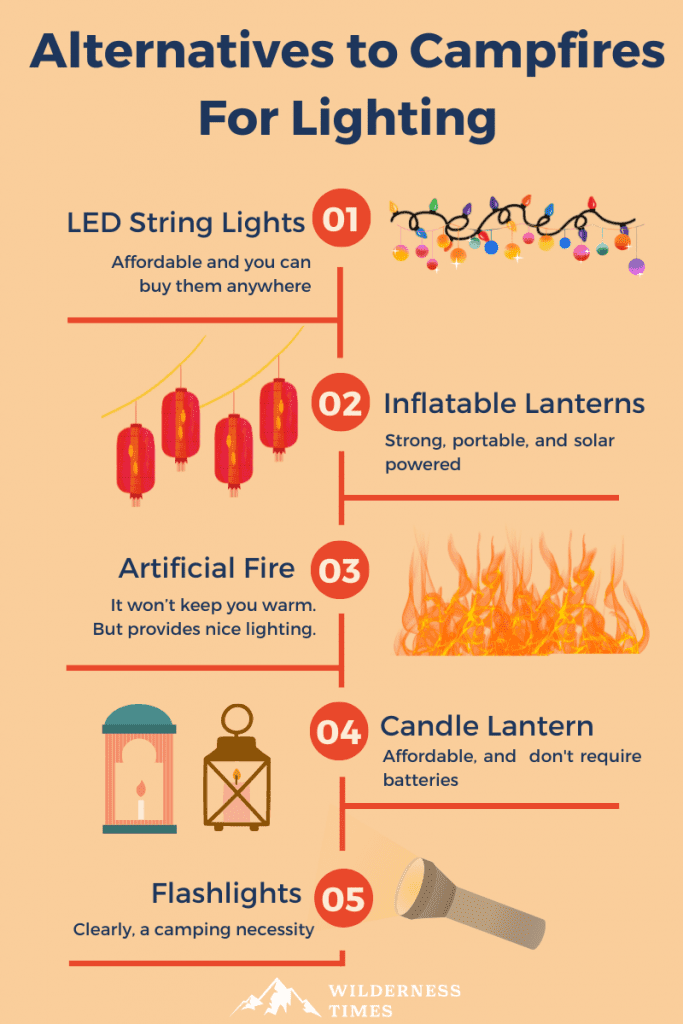
LED String Lights
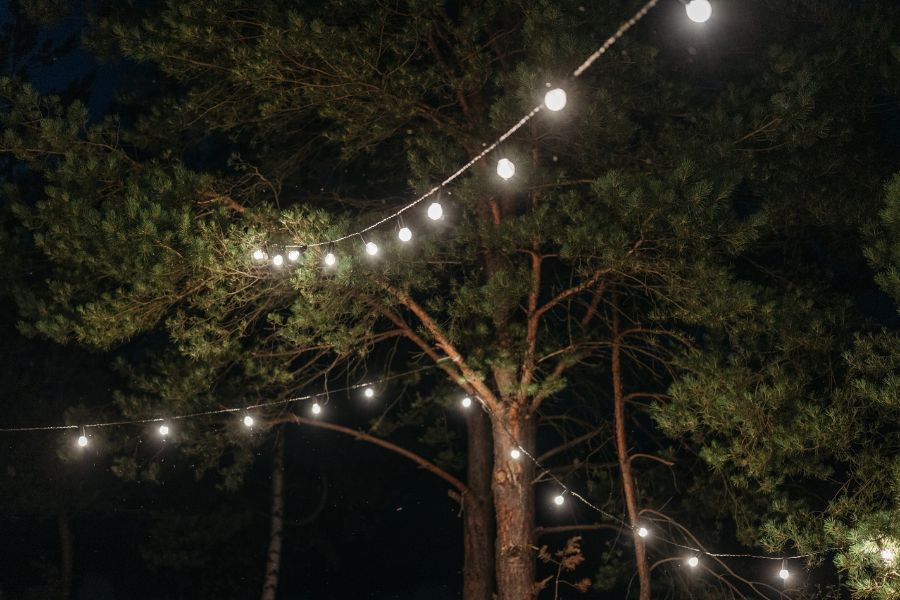
My personal favorite is LED string lights.
They’re affordable and you can buy them practically anywhere, from hypermarkets to home improvement retailers – especially during the holidays.
You can find LED string lights powered with electricity, solar power or batteries. Obviously, you want the last two for camping.
If you go with battery-powered lights, just remember to charge them before heading for the trail. Once full, the batteries will probably last you the entire trip.
Nowadays, you can find tons of different styles, such as bulbs or fairy lights. They also come in different colors.
Add if you decide to go with a tinted one, keep in mind that certain colors attract more bugs than others.
Insects are generally attracted to bright colors like white, yellow and orange.
Instead of picking one of those colors, it’s better to go with more cool-toned hues, like blue or green.
Inflatable Lantern
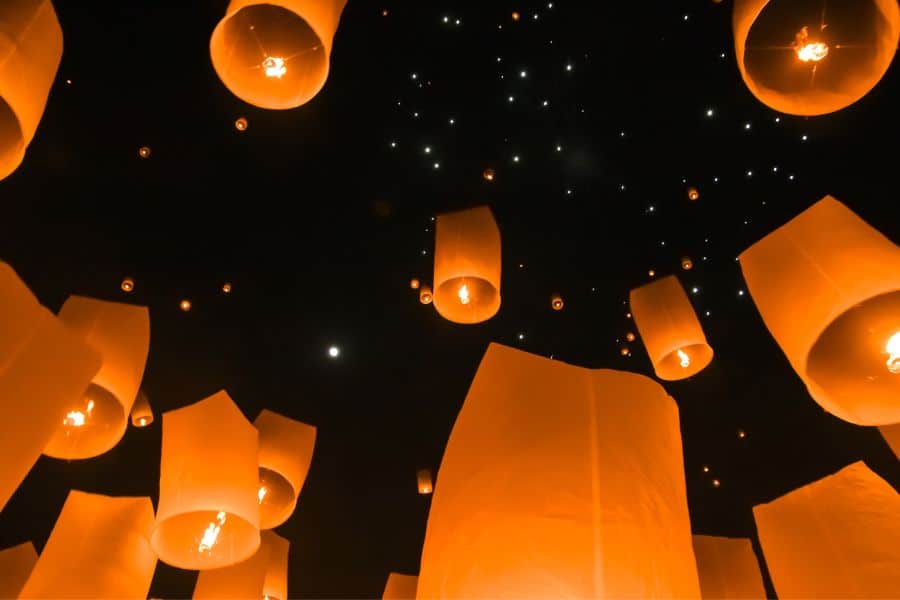
Inflatable lanterns are strong, portable and solar powered. What’s there not to like about them? Oh, that’s right. They’re also rather affordable!
This type of lighting is very efficient. While inflatable lanterns generally need several hours of charging in sun, they’ll surely be going to last you the whole night.
Artificial Fire
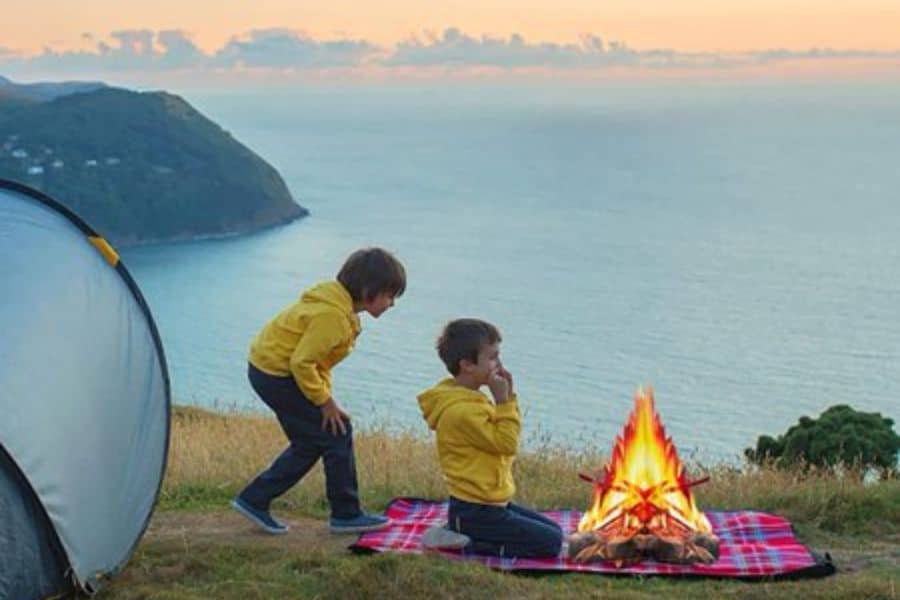
Obviously, artificial fire won’t keep you warm. But if the lighting is all you’re after, then this is definitely an option to consider.
There’s something so relaxing and soporific about the flickering of flames.
However, you should keep in mind that the fan motor of the artificial fire can be loud. What’s more, you’ll also need a power outlet to get this thing running.
Candle Lantern
Now, you might be wondering how can you use a candle lantern during a fire ban.
Well, since the candle flame is completely contained inside the lantern glass frame, there’s really no way a spark can get out
What’s also great about candle lantern is that they’re very affordable and you can find them in practically any store.
Headlamp Bottle Lantern
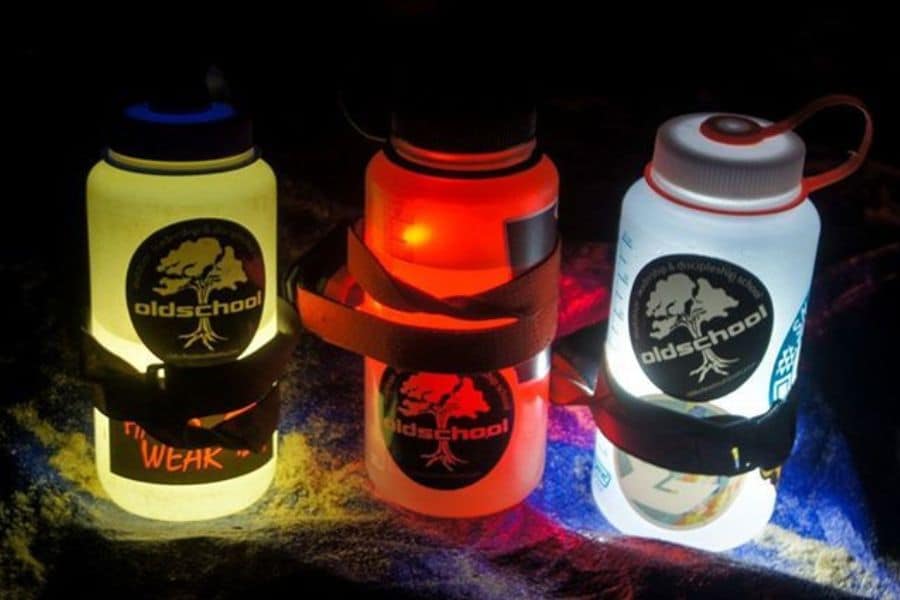
If a headlamp is all you have when it comes to campsite lighting, here’s a neat little trick for you.
Grab a bottle, plastic or glass, doesn’t matter. Fill it with water, then, wrap a headlamp around it.
The light will disperse through the bottle content, enlightening a small area around you.
This DIY lantern won’t turn your campsite into an OR, but it will give you enough light to find your way around the tent.
Flashlight
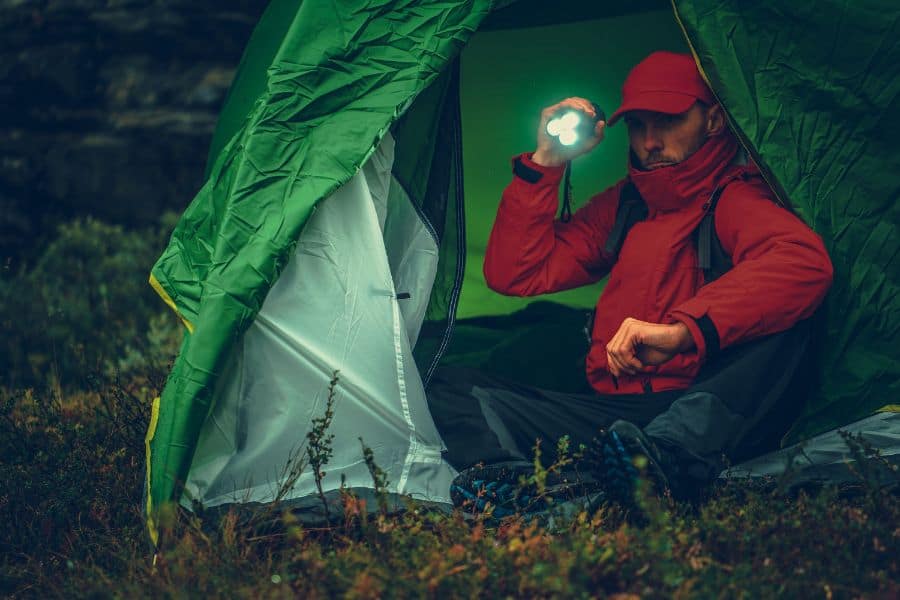
Personally, I can’t imagine a camping trip without a flashlight.
Nowadays, you can find a flashlight in all sizes and colors, as well as of different luminances and battery lives.
So whatever your needs or possibilities are, you can find a suitable product.
Unlike most other options on this list, a flashlight is the most practical one.
It’s lightweight and compact, so you can keep it with you at all times – including inside your sleeping bag’s pocket.
Fun Ideas for Campfire-Free Nights
To be honest, the cracking of the campfire does set the mood for a fun night’s pastime. But that doesn’t mean you actually need it for entertainment.
Stargazing
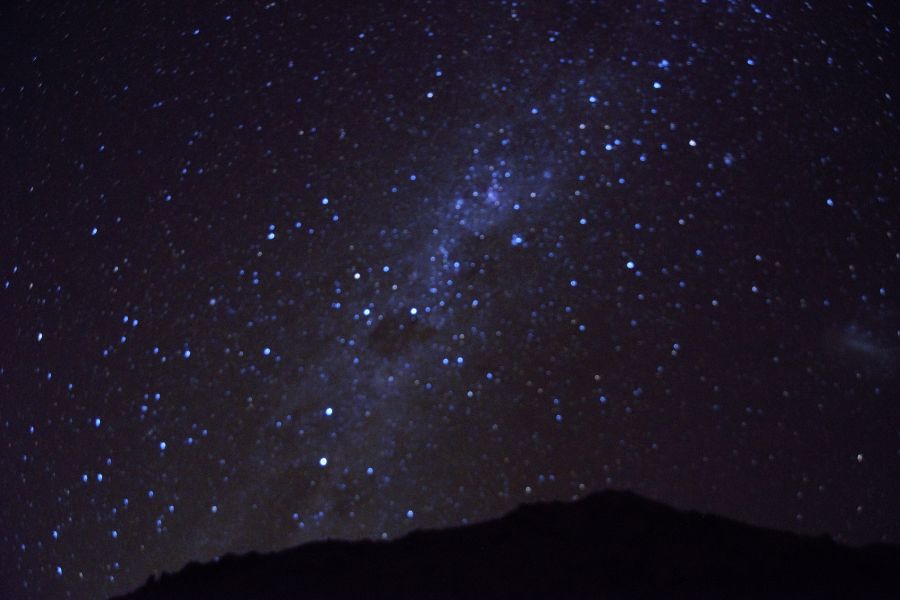
Sitting in the dark?
Look at the bright side, you can use that opportunity for stargazing.
Without flickering campfire flames, you have an unobstructed view of the starry sky above you (given it’s not cloudy).
This is one of the camping activities where using a phone can be quite handy.
There are tons of free apps you can download that give you the name and appearance of different constellations you can see from your location.
To make stargazing even more fun, you can compete against your camping companions in different categories.
For instance, who’s the first one to find the Northern star?
Know that cheap telescope your nephew got for Christmas last year? Well, you’d be surprised what you can see with this little tool.
While you probably won’t end up with a groundbreaking discovery, even those small telescopes will let you see planets and galaxies from a much closer perspective.
See: Best Tents For Stargazing: Sleep Under the Stars in Comfort
Tell Ghost Stories
Gathering around the campfire and telling ghost stories is practically a norm. But let’s be real.
Doing that without a set-up campfire seems even scarier. We all know well that ghosts can easily turn off the lights, don’t we?
Go for a Night Hike
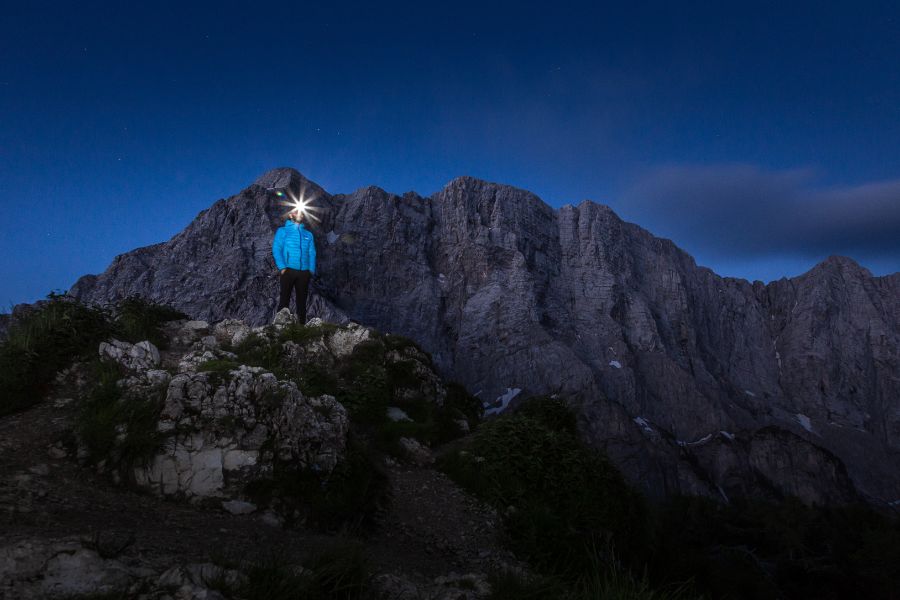
Night hiking is quite a unique experience, for several reasons. First and foremost, you can enjoy a different perspective of the scenery.
And I’m not just talking about the starry sky, but also your surrounding bathed in moonlight.
During hot months, night hiking is also a great way to walk long distances without being slowed down by unbearable heat.
Finally, a night hike really connects you with the environment.
Instead of relying on a flashlight, use the moonlight and your other senses to gather information from your surroundings.
After a while of being in the darkness, your eyes will adjust and you’ll be able to see better around you.
Play a Game
Good ol’ board and card games are also a great source of fun for a camping trip.
The only thing you need is to have some type of lighting available to see what you’re doing.
Or, if you’re feeling energetic, you can play hide and seek, flashlight tag, truth or dare… whatever game you prefer.
Read: The Ultimate List Of 65+ Camping Activities You Need To Try
How to Prepare for Camping Without Fire
If you know there’s a fire ban in place before you head out to the wilderness, then you can do proper preparation at home prior to the trip.
Plan Your Food
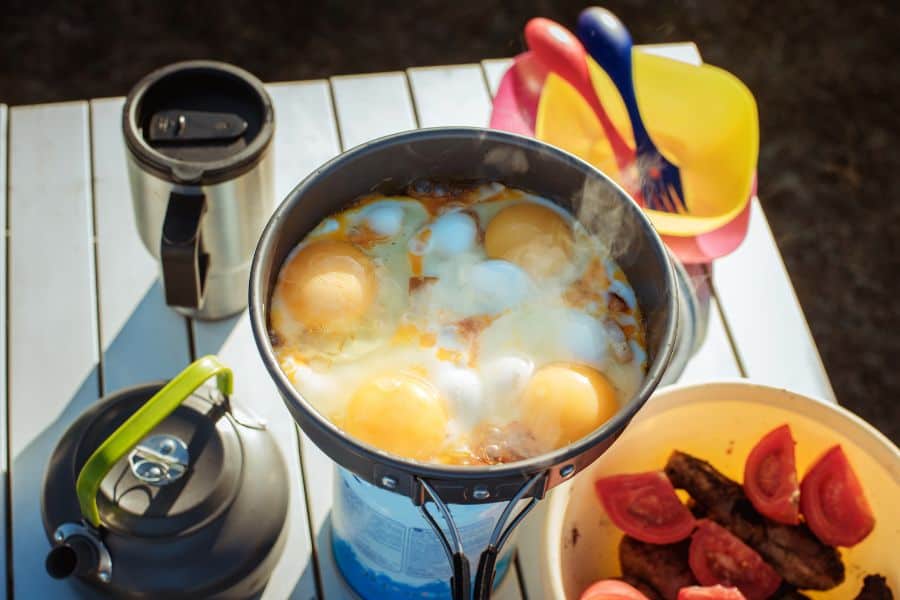
While you should always plan your meals ahead, that’s especially important during fire restrictions.
Bringing food that doesn’t require cooking is probably the easiest option.
Peanut butter sandwiches, overnight oatmeal, trail mix snacks, canned tunas and salads are some of my personal favorite no-cook meals that practically take no prep time.
Alternatively, you can cook your meals at home and bring them to the campsite.
Consider food options like muffins, mashed potato, stews and pays that can sit inside a cooler for a while without going bad.
Read: Genius Camping Food Hacks For Easy Breezy Outdoor Cooking
Bring Nighttime Entertainment
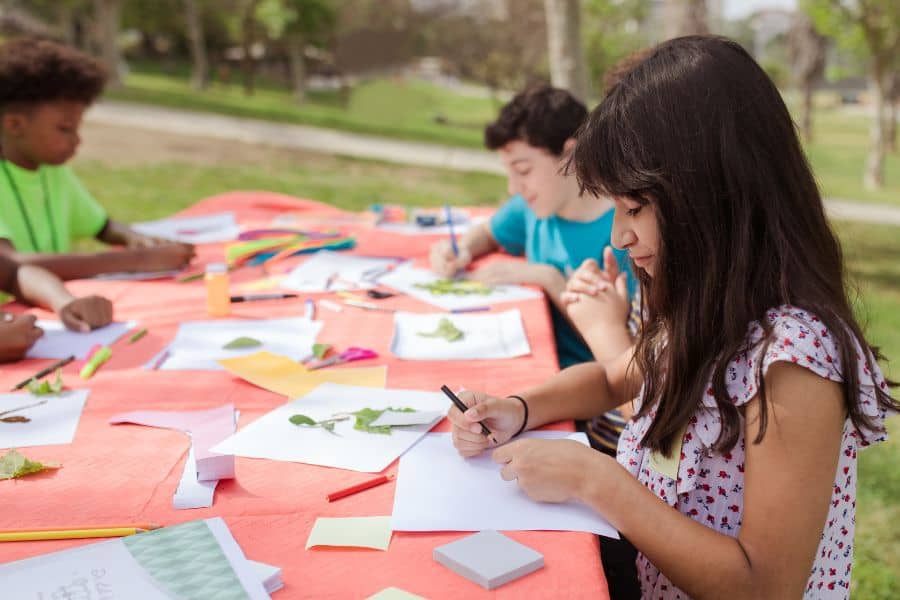
I know it might seem unnecessary, but planning different ways to have fun at night makes a lot of sense.
You don’t want to spend time each night just figuring out what you can do for entertainment.
Cards, board games, dominos and chess are all classic options that most of us already know.
Then, there are some cool glow-in-the-dark games you can play, such as ring toss or bowling.
Of course, there are different ways you can have fun all by yourself.
For instance, you can read a book (on paper or electronic device), listen to music, play an instrument or do sudoku.
Pack Extra Warm
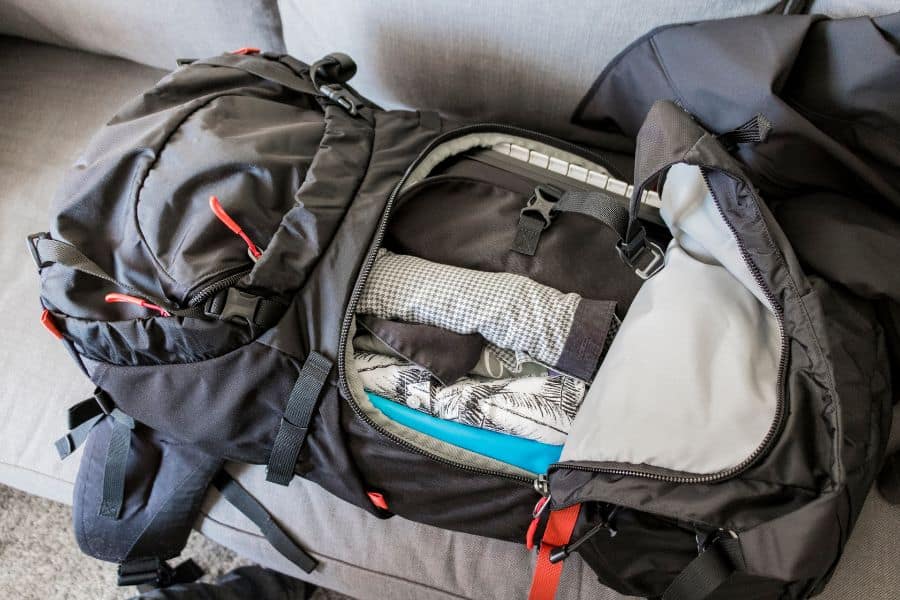
Let’s be honest, nothing makes you warm and cozy on a chilly night like a campfire.
Without it, you can experience quite a bit of temperature fluctuation once the sun goes down.
For that reason, you want to pack extra stuff for staying warm.
Starting with clothes, you should always have some extra hoodies, pajamas and sweatpants that you can put on while hanging out around the campsite.
What’s more, socks and beanies go a long way in keeping you toasty.
Needless to say that you should always bring a sleeping bag with a suitable temperature rating. But you should also be prepared for weather changes.
If storage space is not the issue, bring additional blankets that you can use if the temperature drops below expected.
Don’t Forget The Lighting
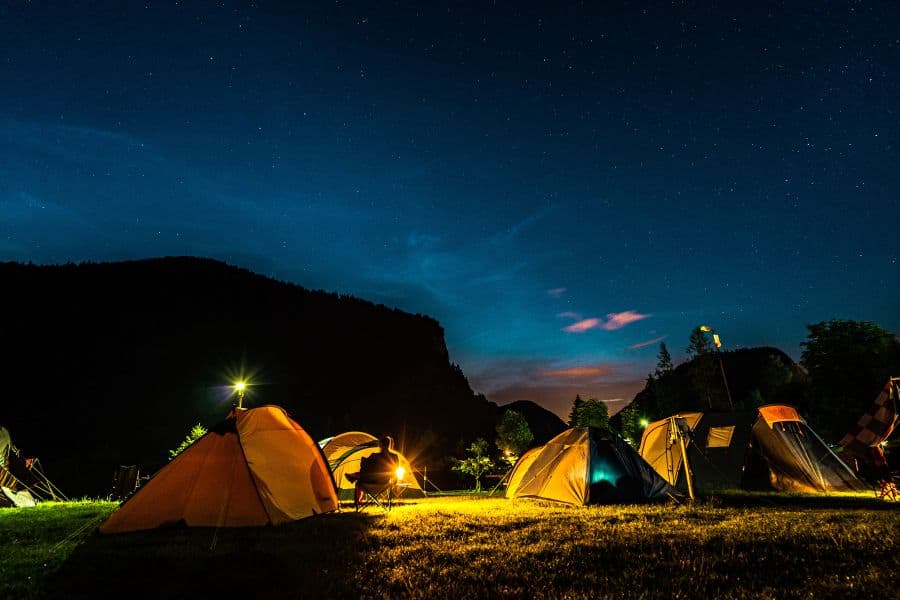
Without a campfire, you’ll need additional lighting sources to see around the campsite at night. Consider packing more than one type of lighting.
While flashlights are great for finding your way around in pitch dark, you want something with a higher light radius to illuminate the campsite.
Oh, and don’t forget to pack whatever you need to power the lighting source, whether it’s batteries, canisters or even a generator.
Of course, remember to charge them completely before the trip.
Plan for Stargazing
No cloudy weather during your camping trip?
Ideal for stargazing.
While you technically can do it without any prior planning, you’ll probably get bored much faster that way.
Now, there’s nothing complex about planning for stargazing.
What you can do before your trip is download a stargazing app (we love SkySafari) or get a star map that will help you identify constellations above you.
Furthermore, you can check out the maps of the area you’re going to for potential stargazing spots. Ideally, you want a location with clear views all around, without high hills and mountains obstructing your view.
Finally, pack a few things that can make the whole activity much more comfortable.
Bring an outdoor blanket as well as some cover-ups, so that you can snuggle up while watching the stars.
Know What Type of Fire is Banned
As we already established, there are two levels of fire bans. Find out which one is in place in your campsite area so that you can prepare accordingly.
For instance, a campfire inside a designated fire ring at campgrounds is allowed during Stage I, but prohibited during Stage II ban.
Cooking Ideas for Campfire Restrictions
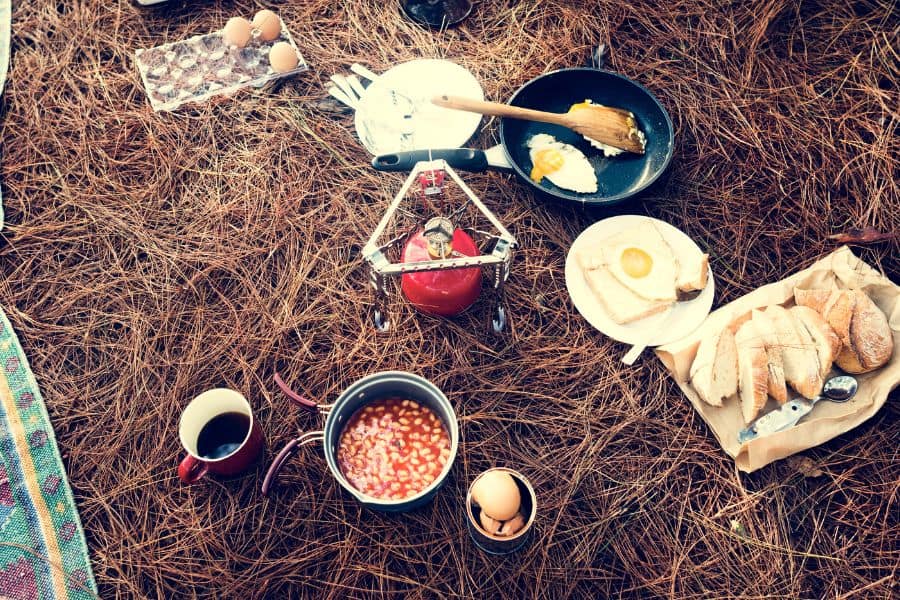
So, what to eat during campfire bans? That depends on what you’re using for cooking.
Here are some ideas you can try out.
Propane Stove
Bacon Avocado Breakfast Wraps – This meal is quick, easy and suitable for making in batches.
What you need to do is slice avocado and make scrambled eggs.
Put both mixtures on the table along with bacon and tortilla, and let each of your group members make their own wrap.
Peanut Butter Chocolate Chip Camp Stove Pancakes – What’s great about pancakes is that you can create a dry mixture at home that you can store at room temperature.
Then at the campsite, just add water, shake and pour onto the pan.
Campfire Stew Dutch Oven Camping Recipe – A propane stove is great for stew.
After a quick meat and veggie prep, the only thing you need to do is let it simmer for a few hours, with an occasional stirring.
The only thing you need to make sure of is to have enough canisters packed to cook for that long.
Shrimp Po Boys – For this meal, the only thing you actually need to prepare on the stove are shrimps, and that shouldn’t take more than a few minutes.
To make your job even easier, buy pre-peeled and deveined shrimps.
Small Propane Grills
Chicken Shish Kabobs – It doesn’t get much simpler than chopping chicken and veggies, then threading them onto skewers.
To make the meat juicier, you can let it sit in the marinade for several hours before cooking.
Grilled Greek Pita Sandwich – For this recipe, you’ll only use the grill to get both pita bread and onions nice and charred.
As for the filling and sauce, you can either prep them at home or on spot.
Chicken Pesto Pizza – Whether you prefer storebought or homemade pesto, both will work for this recipe.
When making pizza on the grill, you want to cook one side first before flipping it and adding toppings next.
Lower the heat once you flip the dough to the other side so that you don’t burn your pizza.
Grilled Flat Iron Camping Steak – This is yet another simple meal to make on the grill.
After marinating the steak for several hours inside the cooler, just place it on the preheated grill and cook for a few minutes on both sides.
Only flip the steak after it stops sticking to the grate.
Portable Electric Cookware
French Toast – Who doesn’t love this simple yet tasty meal? With an electric skillet, you can make about 8 slices at once, making it a great option for larger camping groups.
Electric Skillet Enchiladas – What’s great about enchiladas is how simple they are to put together.
Just mix pre-cooked chicken, sauce, and cheese into an electric skillet, and let it cook for less than 30 minutes.
Caramelized Chicken Wings – While you can prepare this meal on a grill, using an electric skillet is a much better option, as there’s no tedious cleanup afterward.
You can adjust the seasoning to your liking, but honey and soy sauce are important for caramelization.
Skillet Spaghetti – That’s right, you can make a spaghetti meal inside a single electric skillet.
Start by making the sauce, then add uncooked spaghetti and water, then bring to a boil. Then, simmer until tender.
Cream Cheese Wontons – Crispy on the outside and creamy in the middle, wontons are yet another meal that’s quick and easy to make with electric cookware.
You can also fill and fold the wontons one day ahead of time to make meal preparation even simpler.
Lastly, you can check out our Campfire Cooking Recipes & Tips and modify as needed based on your cooking equipment.
FAQs
What are the benefits of using fire pits?
What makes fire pits so great is the fact that they’re versatile. You can use them to make food, warm up and even enlighten the campsite at night.
They’re also easy to use and relatively simple to clean.
What are the types of restrictions?
There are three types of fire restrictions, named Stage I, II and III.
- Stage 1: Fire is prohibited, except for inside a designated ring in a campground. Smoking is prohibited, except for in an enclosed vehicle or building.
- Stage 2: Fire is prohibited, except for devices fueled by liquid petroleum. Smoking is prohibited, except for in an enclosed vehicle or building. Discharging a firearm is prohibited. Mechanical engines and chainsaws are prohibited from 9am to 8pm.
- Stage 3: A total ban from the area, except for law enforcement, firefighters and rangers.
Why are campfires restricted?
During periods of high temperatures and droughts, vegetation dries out, becoming susceptible to burning.
Even a single spark is enough to start a wildfire and quickly spread it. During these dry months, local authorities enforce fire restrictions to minimize the chances of that happening.
What Are the Benefits of Camping in a Fire-Free Zone?
Camping in a fire-free zone does have its perks, the main one being safety.
By using the alternatives mentioned above, you can have peace of mind knowing there’s no way you can cause wildfire and destroy vegetation in an area.
To Sum Things Up
Just because there’s a fire ban in place, that doesn’t mean you can’t enjoy your camping trip to the fullest.
From cooking to staying warm and illuminating the campsite, there are tons of different alternatives you can try out instead.
No matter your storage space, budget, and type of camping trip, there’s something for everyone.
But, if there aren’t any campfire restrictions, be sure to brush up on your campfire safety tips ahead of time!


